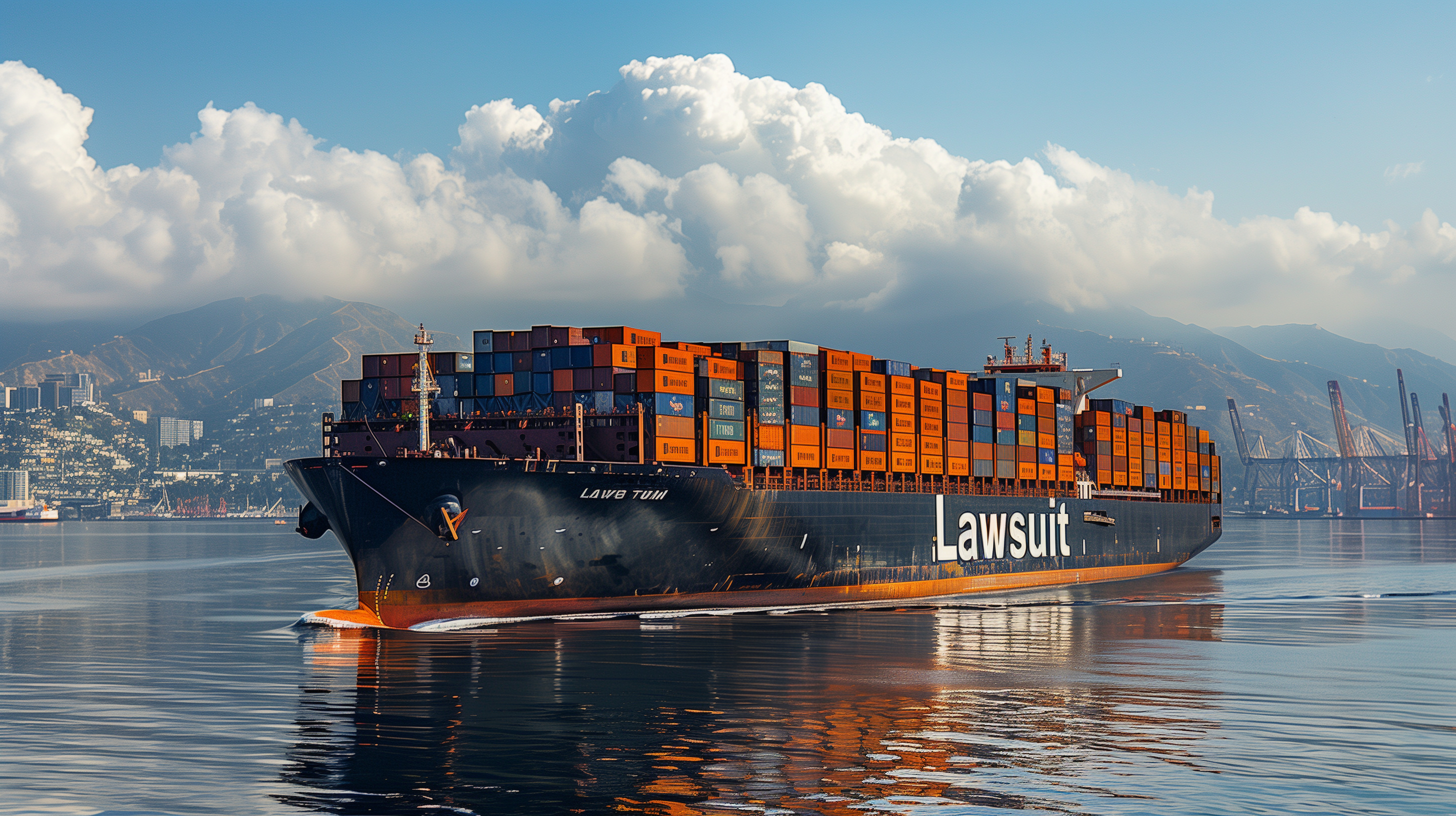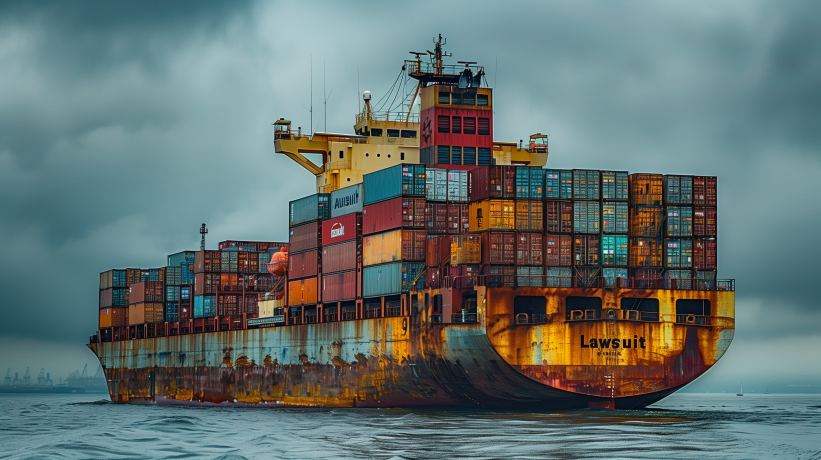
The Port of Los Angeles faces a significant lawsuit alleging thousands of Clean Water Act violations, highlighting concerns about pollution at America's busiest port. This case could influence environmental practices in the maritime industry and may set an important precedent for how large ports are held accountable for their impact on water quality.
by LawInc Staff
July 24, 2024
The Port of Los Angeles has been accused of illegally polluting local waters in violation of the Clean Water Act. A new lawsuit filed by environmental nonprofit Environment California sheds light on the allegations, relevant laws, and what’s at stake for the nation’s busiest port. Here’s your comprehensive guide to understanding this complex case.
From permit requirements to pollution impacts, discharges in question, legal theories, and potential penalties, we break it all down in clear terms. Learn about the evidence, the Clean Water Act provisions in play, and what it all means for the Port and the environment.
Whether you’re a concerned citizen, legal observer, Port employee, policymaker or just want to stay informed, this in-depth overview will get you up to speed on this high-stakes water pollution lawsuit against the Port of LA.
1. Understand the Allegations & Violations Claimed
-
- Illegal Discharges from Port’s Pump Station: The lawsuit alleges the Port is violating pollution limits in the wastewater permit for its New Dock Street Pump Station.
- Excessive Bacteria, Metals & Petroleum: Sampling data shows violations for enterococcus, fecal coliform, total coliform, copper & hydrocarbons.
- Bypassing Pollution Controls: The complaint claims the Port illegally diverts wastewater around required treatment systems when flows are high.
- Failure to Report Bypasses: The suit says the Port doesn’t notify regulators of bypass events as mandated.
- Violating the Clean Water Act: These permit violations are unlawful under the federal Clean Water Act, per the allegations.
Key Permit Limits Allegedly Violated
-
- Enterococcus Bacteria: 104 MPN/100mL daily max, 35 MPN/100mL monthly avg
- Fecal Coliform Bacteria: 400 MPN/100mL daily max
- Total Coliform Bacteria: 10,000 MPN/100mL daily & monthly
- Copper: 6.9 ug/L daily max, 2.6 ug/L monthly avg
- Petroleum Hydrocarbons: 100 ug/L daily max
Scope of Alleged Violations
-
- Over 2,400 Permit Violations: Since 2018 when pollution controls installed
- Thousands of Violations: Going back over 20+ years of the permit’s history
- Discharges Up to 23,000%+ Over Limits: Tables list violations up to 230x permitted levels
- 124 Bypass Violations: Treatment systems circumvented 124 times from 2019-2024
- Violations Increasing: Annual violation numbers appear to be trending upwards in recent years
FAQs: The Basics
-
- Who filed the lawsuit and when? On July 23, 2024, the non-profit environmental organization Environment California filed a citizen suit.
- Who are the defendants? The City of LA, LA Harbor Department (aka Port of LA), and LA Board of Harbor Commissioners.
- What do plaintiffs want? A court order to stop violations, bring the Port into compliance, penalties, and monitoring/mitigation.
- How was this suit allowed? The Clean Water Act allows citizen enforcement if regulators aren’t diligently prosecuting.
- What’s the big deal? The scope, duration & degree of violations alleged are alarming for such a major US port.
2. Learn About the Clean Water Act Provisions at Issue
-
- NPDES Permit Program: CWA Section 402 requires pollutant dischargers to get permits with limits & conditions to protect waters.
- “Point Source” Discharges: Permits apply to any discernible, confined, discrete conveyance of pollutants to navigable waters.
- Blanket Prohibition on Violations: CWA Section 301 flatly prohibits discharging in violation of a permit’s requirements.
- Mandatory Pollution Monitoring: CWA Section 308 requires dischargers to sample waste streams and report results.
- Citizen Suit Enforcement: CWA Section 505 lets citizens sue permit violators if regulators haven’t in federal court.
Why the Clean Water Act Matters
-
- Before 1972 CWA passage, rampant uncontrolled pollution plagued US waters
- CWA permitting revolutionized oversight by limiting discharges & requiring monitoring
- NPDES permits now cover ~60,000 dischargers nationwide
- Citizen enforcement is a critical CWA safeguard – nearly 75% of actions are citizen suits
- CWA widely credited with making US waters safer for drinking, swimming, fishing
How the Clean Water Act Applies Here
-
- The pump station discharges from a “point source” to the Cerritos Channel, so needs an NPDES permit
- The facility’s NPDES permit was 1st issued in 1997, last updated in 2019 – violations span permit terms
- Numeric effluent limits, discharge monitoring, and bypass conditions & reporting are all permit requirements
- Each violation of any permit condition is considered a Clean Water Act violation, per CWA Section 301
- Alleged permit violations appear ongoing, so citizen enforcement is allowed under CWA Section 505
FAQs: Clean Water Act
-
- Who administers NPDES permits? Mostly states (like California), with US EPA oversight. The permit was issued by the LA Regional Water Quality Control Board.
- Are permit violations common? Yes – a seminal 2022 report found that 83% of CA major industrial dischargers violated permits at least once in a 21-year period.
- What’s a citizen suit? A lawsuit by a private party (person or org) to enforce an environmental law against an alleged violator, as allowed under the CWA, Clean Air Act & other statutes.
- Does a citizen suit replace government action? No, it’s a supplement – plaintiffs must give 60-days notice & can only proceed if regulators aren’t already prosecuting.
- What can a citizen suit accomplish? The court can order compliance, impose civil penalties, award attorney fees – leveling the playing field.
3. Dive into the Port’s Wastewater Treatment
-
- New Dock Street Pump Station: Built in 1996 to collect stormwater & groundwater infiltration from a 53-acre area.
- Multi-Stage Treatment System: Added in 2018 to remove pollutants before discharging. Includes settling, aeration, filtration & UV.
- Bacteria, Metals, Toxics in Discharges: System meant to reduce bacteria, copper, hydrocarbons & more in pump station wastewater.
- Limited Treatment Capacity: Aquip filtration unit only handles 80 gallons/min (115,000 gal/day) but permit allows 7.25 million gal/day.
- Bypasses When Overloaded: Flows over 80 gal/min skip filtration, UV stages & only partially treated wastewater is discharged.
What’s in Pump Station Wastewater?
-
- Bacteria: Enterococcus, fecal coliform & total coliform indicating possible fecal contamination
- Metals: Copper, lead, zinc, nickel & more – toxic to marine life even at low levels
- Petroleum: Oil, grease, gasoline compounds – lethal & sub-lethal effects on organisms
- Legacy Toxics: PCBs, DDT, other pollutants banned but still detected in area sediments
- Other Contaminants: Nutrients, suspended solids & more typical in urban runoff
Impacts of Alleged Pollution Discharges
-
- Public Health: Bacteria may sicken swimmers, surfers, fishers. Toxics accumulate in fish consumed by humans.
- Aquatic Life: Metals & petroleum can kill marine life directly or impair reproduction, growth, immune function.
- Environmental Justice: Pollution often hits disadvantaged communities who rely on the harbor for subsistence fishing & recreation hardest.
- Economic Costs: Illnesses, cleanup needs & declining tourism from pollution has major financial tolls locally & regionally.
- Ecological Damage: Excess contaminants throw off nature’s balance, degrading the marine ecosystem’s health & diversity.
FAQs: The Port’s Permit & Pollution
-
- How does the Port measure discharges? Permit requires sampling for bacteria, metals, toxics & more – some continuously, some annually.
- What proof is there of violations? The complaint includes extensive data tables showing alleged permit exceedances from the Port’s own reports.
- Isn’t stormwater runoff exempt? No – this is a permitted discharge. Even if some runoff is unavoidable, violating limits is still illegal.
- Does the Port acknowledge the violations? The complaint notes that the Port’s monitoring submissions are considered conclusive admissions.
- Is the data reliable? Presumably yes – the CWA requires permittees to certify the accuracy of monitoring data under penalty of law.
4. Examine the Complaint’s Key Claims & Theories
-
- Violation of Permit Effluent Limits: Each measurement over the numeric limits for bacteria, metals, petroleum is a CWA violation.
- Monthly vs. Daily Violations: Exceeding a monthly average limit counts as violations for each day of the month.
- Illegal Bypasses: Every time flows bypass treatment (likely 124+ times from 2019-2024) is a separate CWA violation.
- Failure to Report Bypasses: For each required notice to regulators that wasn’t provided, the Port violated the CWA again.
- Veil of Permit Shields No Defense: Having a permit is no defense to violating its terms. Each broken condition is illegal.
Legal Elements & Evidence Needed
-
- Point Source: Is the pump station a discernible, confined, discrete conveyance? Discharge pipes are classic point sources.
- Discharge to Navigable Waters: Does Cerritos Channel connect to the Pacific? Harbors, bays, estuaries all count.
- Violations of Permit Conditions: Do Port records confirm exceeding limits, illegal bypasses, reporting failures? DMRs are self-reported.
- Jurisdiction: Did any of the violations occur within the last five years, falling within the statute of limitations? Tables show violations up to 2024.
- Ongoing Violations: Are some types of violations likely continuing? Complaint alleges nothing has changed.
Potential Court Rulings & Remedies
-
- Declaratory Judgment: Affirming the alleged CWA violations occurred as a matter of law and are ongoing
- Injunctive Relief: Ordering the Port to comply with all permit terms, expand treatment capacity, stop illegal bypasses
- Civil Penalties: Imposing monetary fines up to $60,000+ per day/violation (likely millions) to punish violations & deter future ones
- Mitigation Projects: Requiring defendants to fund LA Harbor restoration, water quality monitoring, pollution prevention
- Attorney Fees: Having the Port reimburse Environment CA for costs of litigation, expert fees, court expenses
FAQs: Litigation Outlook
-
- What defenses could the Port raise? Perhaps that the data is inaccurate, violations were unintentional flukes, or that regulators have been lax.
- Could the case settle out of court? Possibly, if the Port agrees to major systemic changes, mitigation & penalties without full trial.
- Why wasn’t the Regional Board pursuing this? Regulators often have limited resources, are subject to political pressure, or prefer to negotiate administratively.
- Will the lawsuit force a permit update? It may expedite & strengthen pollution limits in the Port’s next iteration of its discharge permit.
- What’s the timeline for the case? Federal lawsuits often take years, unless there’s an early motion to dismiss or a quick settlement.
5. Learn Why This Case Matters for People & the Planet
-
- Health of LA’s Waters: Excessive bacteria, metals & toxics endanger humans & harm the marine ecosystem. This is about safe, clean water for everyone.
- Economies & Equity: The burdens & costs of the Port’s pollution hit disadvantaged communities, coastal businesses & taxpayers hardest.
- Holding Polluters Accountable: Big dischargers have duties under the law. If regulators fail to enforce, citizens can be private attorneys general.
- Motivating Pollution Prevention: Swift, serious consequences for violations spur investment in treatment upgrades, monitoring, alternatives.
- Spotlight on Stormwater: This case shows how critical it is to control industrial runoff. It’s not all coming from the sky – we’ve created the problem and the law requires solving it.
LA Harbor’s Complex Challenges
-
- Nearly 1 in 6 LA County residents live in polluted “disadvantaged communities,” often near industry hotspots like the Port
- The LA region has struggled to meet water quality standards for decades – still over 100 impaired waters locally
- Climate change is increasing extreme storm events, overburdening already inadequate stormwater infrastructure
- The Port is a huge economic engine for LA, but with that comes major pollution externalities that can’t be ignored
- Legacy of the L.A. River – paved over for commerce & flood control, but at a high environmental & community cost
Opportunities in the Outcome
-
- Improving LA Water Quality: Forcing remedies, deterring violations will mean cleaner beaches, harbor, seafood, recreation
- Driving Green Infrastructure: Investing in nature-based stormwater solutions with co-benefits for habitat, climate, communities
- Enhancing Public Health: Reducing toxic pollutants in fish & waters means healthier people, especially in over-burdened areas
- Saving Taxpayer Dollars: Making violators pay for harm avoids public cleanups later. An ounce of prevention is worth a pound of cure.
- Signaling Sustainability Shift: Holding the Port accountable shows LA is getting serious about being a true environmental leader
FAQs: The Bigger Picture
-
- Is this problem unique to the Port of LA? No, but as the largest US port, LA has an outsized impact and responsibility. Where LA leads, others follow.
- Will this make the Port less competitive? The CWA applies to all ports. Clean water investment is good for business – no one wants to swim, fish or boat in pollution.
- What about other pollution sources? Other dischargers are subject to the same rules and lawsuits when violations occur. This focuses on one major actor.
- Will a lawsuit really change things? Past CWA citizen enforcement has forced cleanups, technology upgrades, millions in mitigation locally & nationally.
- What can I do? Support clean water nonprofits, report pollution, reduce your stormwater footprint, tell leaders to hold polluters accountable.
The Bottom Line

Will LA’s waters be safe for dolphins, or deadened by pollution? The Port’s lawsuit may shape the outcome.
This landmark Clean Water Act lawsuit against the Port of Los Angeles has major implications for the future of LA’s waters and beyond. With years of alleged violations pouring bacteria, metals, toxics & more into local waters, the outcome could be a watershed moment.
The case shines a light on the Port’s pollution problems and the health & equity impacts, while offering a chance to set a stronger standard for clean water accountability. A win for the plaintiffs could mean a crucial course correction toward swimmable, fishable waters for all.
As the complaint makes its way through court, expect the defendants to have their day too. But however the details unfold, one thing is clear: with the LA Harbor, the city’s economy, and public health in the balance, this is a lawsuit to watch. The future of one of America’s most important waterbodies could hang in the balance.
Concerned About This Case? Here’s What You Can Do
If you’re troubled by the allegations of illegal water pollution outlined in this lawsuit against the Port of LA, know that you can make your voice heard. Here are some ways to get informed and involved:
- Follow media coverage and official case updates to stay informed on lawsuit developments
- Voice your concerns to the LA Mayor, Board of Harbor Commissioners, and your local representatives
- Support the work of environmental watchdogs like Environment California that serve as a check on big polluters
- Attend public meetings on Port of LA activities and speak up for clean water as a priority
- Reduce your own stormwater pollution footprint by properly maintaining your vehicle, yard, and home
Test Your Clean Water Act & NPDES Knowledge
Questions: NPDES Permit Basics
-
- 1. Which federal law created the NPDES permit program?
- A) Clean Air Act
- B) Clean Water Act
- C) Safe Drinking Water Act
- D) Resource Conservation & Recovery Act
- 2. What does NPDES stand for?
- A) National Pollution Discharge Effluent Standards
- B) Navigable Waters Permitting & Delegation System
- C) National Pollutant Discharge Elimination System
- D) Nonpoint Source Pollution Deterrent & Enforcement Strategy
- 3. Who is usually responsible for issuing NPDES permits?
- A) The President
- B) U.S. Congress
- C) Environmental Protection Agency
- D) Authorized state agencies
- 4. What types of discharges do NPDES permits regulate?
- A) Any discharge to groundwater
- B) Air emissions from factories
- C) Runoff from farm fields
- D) Effluent from point sources to surface waters
- 5. NPDES permits typically include which of the following?
- A) Effluent limits on certain pollutants
- B) Monitoring & reporting requirements
- C) Pollution prevention conditions
- D) All of the above
- 1. Which federal law created the NPDES permit program?
Answers: NPDES Permit Basics
-
- 1. B) The Clean Water Act of 1972 established the NPDES permit program to regulate water pollution.
- 2. C) NPDES = National Pollutant Discharge Elimination System, the primary US program for regulating point sources.
- 3. D) Most states are now authorized to administer NPDES permits themselves, with EPA oversight.
- 4. D) NPDES permits apply to point source discharges of pollutants to waters of the US, not air emissions or most runoff.
- 5. D) All NPDES permits contain effluent limits & required monitoring, reporting, and pollution prevention planning.
Questions: Enforcement & Liability
-
- 1. Under the Clean Water Act, who can sue a discharger for NPDES permit violations?
- A) Environmental groups
- B) State agencies
- C) EPA
- D) All of the above
- 2. Does an NPDES permit shield the permit holder from all liability?
- A) Yes, any discharge is allowed as long as you have a permit
- B) Yes, but only if the permit was properly issued
- C) No, you can still be liable for violating the permit’s conditions
- D) No, but only if you acted negligently
- 3. What is the statute of limitations for filing a citizen suit regarding NPDES permit violations?
- A) 1 year
- B) 3 years
- C) 5 years
- D) No time limit
- 4. What are the potential penalties for an NPDES permit violation?
- A) Injunctive relief (court order to take action)
- B) Civil penalties up to $60,000+ per day
- C) Criminal fines and jail time
- D) All of the above
- 5. How can a discharger contest an alleged NPDES permit violation?
- A) Argue the permit conditions are too vague
- B) Challenge the validity of monitoring data
- C) Claim the violation was unintentional
- D) All of the above
- 1. Under the Clean Water Act, who can sue a discharger for NPDES permit violations?
Answers: Enforcement & Liability
-
- 1. D) The CWA allows EPA, states, and citizen groups to all enforce against NPDES permit violators in federal court.
- 2. C) An NPDES permit is not a free pass to pollute – violations of the permit terms are still illegal and actionable.
- 3. C) The statute of limitations for a Clean Water Act citizen suit is 5 years from when the violations occurred.
- 4. D) A court can order injunctive relief, penalties over $50K per day, and even criminal sanctions in egregious cases.
- 5. D) While those defenses can be raised, courts often defer to agency permit-writing and treat permittee monitoring data as admissions.
Disclaimer
The legal information and opinions provided in this article analyzing the Clean Water Act lawsuit against the Port of Los Angeles are for general educational purposes only. Nothing herein should be construed as formal legal advice.
This case study is based solely on a review of the publicly available complaint and is not a comprehensive statement of all relevant facts or laws. As the lawsuit progresses, new details may emerge that could impact the current analysis.
For questions about your specific legal rights or remedies relating to Port of LA pollution, please consult an experienced environmental attorney licensed to practice in your jurisdiction. The outcome of this litigation is not yet determined.
Also See
Classroom Confidential: Inside the Explosive Lawsuit Challenging California’s AB 1955










